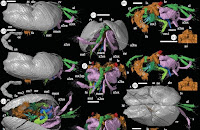The Marrellomorphs are a poorly understood group of early Arthropods known from Palaeozoic deposits at a number of sites around the world. They are not thought to have had any mineralized parts, making them rare in the fossil record, and to date only three species have been described; Marrella splendens, which is the most abundent Arthropod fossil in the Middle Cambrian Burgess Shale of British Columbia, Furca bohemica from the Late Ordovician Letná Formation of the Czech Republic and Mimetaster hexagonalis from the Devonian Hunsrück Slate of Germany, though a number of other un-named Marrellomorphs are known from other sites, including the Early Ordovician Fezouata Formation of Morocco, the Early Cambrian Balang Formation and Middle Cambrian Kaili Formation of China and Ordovician sediments from Argentina.
In a paper published in the journal Acta Palaeontologica Polonica on 29 March 2016, David Legg of the Oxford University Museum of Natural History describes a new species of Marrellomorph Arthropod from the Middle Ordovician Llanfallteg Formation of Northern Pembrokeshire, Wales.
The specimen is described as Dyrnwynia conollyi, where 'Dyrnwynia' refers to 'Dyrnwyn' a mythical flaming sword from Welsh mythology, and 'conollyi' honours Cedric Conolly for his work on the Cat’s Hole Quarry, which produced the specimen from which the species is described, and related sites in Northern Pembrokeshire. The specimen comprises a single a mediolateral spine measuring 16 mm in length, with numerous secondary spines on its outer surface.
Marellomorph arthropod Dyrnwynia conollyi from the Llanfallteg Formation, Didymograptus artus Biozone, Darriwilian, Ordovician; Pembrokeshire, Wales, UK. Isolated mediolateral spine. (A) Photograph. (B) Camera lucida drawing. Legg (2016).
See also...
 Pentecopterus decorahensis: A Eurypterid 'Sea Scorpion' from the Middle Ordovician of Iowa. The
Eurypterids were a curious group of Chelicerate...
Pentecopterus decorahensis: A Eurypterid 'Sea Scorpion' from the Middle Ordovician of Iowa. The
Eurypterids were a curious group of Chelicerate... Three dimensional soft tissue preservation in a Myodocope Ostracod from the Herefordshire Lagerstätte. Ostracods are small Crustaceans which conceal their bodies between two
large valves in a bodyplan convergent with the...
Three dimensional soft tissue preservation in a Myodocope Ostracod from the Herefordshire Lagerstätte. Ostracods are small Crustaceans which conceal their bodies between two
large valves in a bodyplan convergent with the...  A Marrellomorph Arthropod from the Late Ordovician of the Czech Republic. The enigmatic fossil Furca bohemica was first recorded from Late
Ordovician deposits at Veselá Gorge, in what is now the Czech Republic,
by the French Palaeontologist Joachim Barrande in 1846, though...
A Marrellomorph Arthropod from the Late Ordovician of the Czech Republic. The enigmatic fossil Furca bohemica was first recorded from Late
Ordovician deposits at Veselá Gorge, in what is now the Czech Republic,
by the French Palaeontologist Joachim Barrande in 1846, though...
Follow Sciency Thoughts on Facebook.

